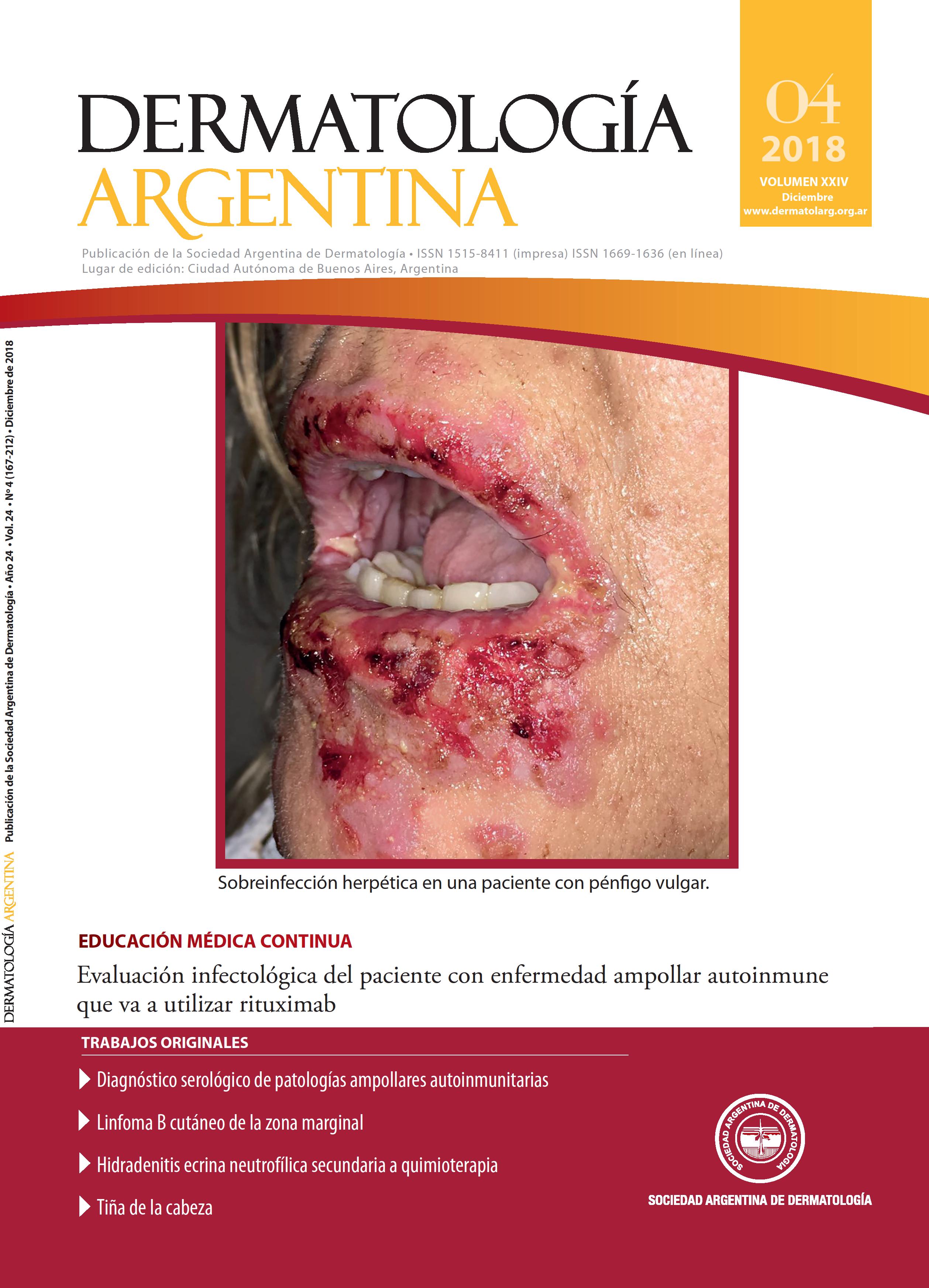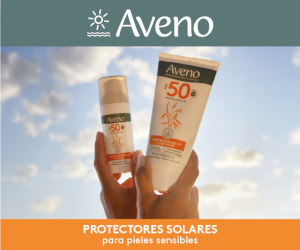Infectological evaluation of the patient with autoimmune bullous dermatosis who will use rituximab
Keywords:
immunosuppression, pemphigus, rituximabAbstract
Conventional treatment of patients with autoimmune bullous diseases relies on global immunosuppression with the use of corticosteroids and other immunosuppressive drugs to decrease the titers of autoantibodies responsible for these diseases. In recent years the appearance of biological therapy has improved the management and prognosis of them. Rituximab (RTX) is a chimeric (murine) monoclonal antibody, targeting CD20 on both normal and malignant B lymphocytes, and leading to a rapid depletion of these cells for 6 to 9 months. In Argentina, Administración Nacional de Medicamentos, Alimentos y Tecnología Médica (ANMAT) approved rituximab in 2012, under the same indications as the Food and Drug Administration (FDA), with bullous diseases being also an indication outside the accepted (“off label”), although some authors already consider it the first line of treatment for patients with moderate to severe pemphigus. However, rituximab can cause adverse effects and complications, so it is important to take preventive measures. This paper summarizes the main considerations to be taken into account in a patient receiving biological therapy.References
I. 1. Huang A, Madam R, Levitt J. Future for pemphigus vulgaris: Rituximab and beyond. J Am Acad Dermatol 2016;74:746-753.
II. Jordán R, Valledor A. Guías de recomendaciones de prevención de infecciones en pacientes que reciben modificadores de la respuesta biológica. Rev Arg Reumatol2014;25:8-26.
III. Koo S, Marty FM, Baden L. Infectious complications associated with immunomodulating biologic agents. Hematol Oncol Clin N Am 2011;25:117-138.
IV. Kasperkiewicz M, Schmidt E, Zillikens D. Current therapy of the pemphigus group. Clin Dermatol 2012;30:84-94.
V. Vaglio Giors G, Torre A, Volonteri V, Kowalczuk A, et ál. Rituximab en pénfigo ¿una alternativa terapéutica? Dermatol Argent 2013;19:106-111.
VI. Murrell D, Peña S, Joly P, Marinovic B, et ál. Diagnosis and management of pemphigus: recommendations by an international panel of experts. [en línea]. Jour AM Acad Dermatol 2018. doi: https://doi.org/10.1016/j.jaad.2018.02.021 [consulta: 20 diciembre 2018].
VII. Disposición 3563-12, Ministerio de Salud, Secretaría de Políticas, Regulación e Institutos ANMAT, Buenos Aires, 18 de junio de 2012. www.anmat.gov.ar/boletin_anmat/junio_2012/Dispo_3563-12.pdf [consulta: 20 diciembre 2018].
VIII. Fatourechi M, Gibson LE. Rituximab: applications in Dermatology. Int J Dermatol 2006;45:1143-1155.
IX. Graves J, Nunley K, Heffernan M. Off-label uses of biologics in dermatology: rituximab, omalizumab, infliximab, etanercept, adalimumab, efalizumab and alefacept (part 2 of 2). J Am Acad Dermatol 2007;56:55-79.
X. Sterling TR, Chaisson RE. Manifestaciones clínicas generales de la infección por el VIH (incluidos el síndrome retroviral agudo y las enfermedades orales, cutáneas, renales, oculares, metabólicas y cardíacas). En: Mandell, Douglas and Bennett. Principles and practice of infectious disease. 7th ed. Elsevier; 2010.
XI. Van der Meer J. Defects in host defense mechanisms. En: Rubin RH,et ál.Clinical approach to infections in compromised host. Springer, New York; 2002.
XII. Genovese MC, Breedveld FC, Emery P, Cohen S, et ál. Safety of biological therapies following rituximab treatment in rheumatoid arthritis patients. Ann Rheum Dis 2009;68:1894-1897.
XIII. Recomendaciones Nacionales Vacunación Argentina 2012.http://www.msal.gob.ar/images/stories/bes/graficos/0000000451cnt-2013-06_recomendaciones-vacunacion-argentina-2012.pdf. [consulta: 20 diciembre 2018].
XIV. Nemirosky C. Puesta al día en vacunación antineumocócica en adultos. Rev Hosp Ital B Aires 2015;35:97-101.
XV. CDC. The Pink Book.Epidemiology and Prevention of Vaccine-Preventable Diseases. Hepatitis B:158-171. Disponible en: https://www.cdc.gov/vaccines/pubs/pinkbook/prinvac.html [consulta: 20 diciembre 2018].
XVI. Salliot C, Dougados M, Gossec L. Risk of serious infections during rituximab, abatacept and anakinra treatments for rheumatoid arthritis: meta-analyses of randomised placebo controlled trials. Ann Rheum Dis 2009;68:25-32.
XVII. Zumla A, Raviglione M, Hafner R, Von Reyn F. Tuberculosis. N Engl J Med 2013;368:745-755.
XVIII. OMS (Organización Mundial de la Salud). Directrices sobre la atención de la infección tuberculosa latente 2015.Disponible en: https://www.who.int/tb/publications/latent-tuberculosis-infection/es/ [consulta: 20 diciembre 2018].
XIX. Incani R, Hernández M, González ME. Hyperinfection of Strongyloides stercoralis probably associated with rituximab in a patient with mantle cell lymphoma and hyper eosinophilia. Rev Inst Med Trop SaoPaulo 2010;52:221-224.
XX. OPS (Organización Panamericana de la Salud). Guía para el diagnóstico y tratamiento de la enfermedad de Chagas 2018;172:8. Disponible en: http://iris.paho.org/xmlui/handle/123456789/49653 [consulta: 20 diciembre 2018].
XXI. Alexandre K, Ingen-Housz-Oro S, Versini M, Sailler L, et ál. Pneumocystis jirovecii pneumonia in patients treated with rituximab for systemic diseases: Report of 11 cases and review of the literature. Eur J Intern Med 2018;50: e23-e24.
XXII. Hoofnagle J. Reactivation of hepatitis B. Hepatology2009;49:S156-S165.
XXIII. Yeo W, Johnson P. Diagnosis, prevention and management of hepatitis B virus reactivation during anticancer therapy. Hepatology 2006;43:209-220.
XXIV. Feld J. HBV treatment in a patient who will be receiving immunosuppresive theraphy. Clin Liv Dis 2013:34-37.
XXV. Lok AS, MacMahon B. Chronic hepatitis B: Update 2009. Hepatology 2009;50:661-662.
XXVI. European Association for the study of the liver. Clinical Practice Guidelines: Management of chronic Hepatits B virus infection. J Hepatol 2012;57:167-185.
XXVII. Terrault N, Bzowej N, Chang K, Huang J, et ál. AASLD Guidelines for treatment of chronic Hepatitis B. Hepatology2016;63:261-283.
XXVIII. Carson K, Evens A, Richey E, Habermann T, et ál. Progressive multifocal leukoencephalophathy following rituximab theraphy in HIV- negative patients: a report of 57 cases from the Research on Adverse Drug Events and Reports (RADAR) Project. Blood2009;113:4834-4840.
Downloads
Published
Issue
Section
License
Copyright (c) 2018 Argentine Society of Dermatolgy

This work is licensed under a Creative Commons Attribution-NonCommercial-NoDerivatives 4.0 International License.
El/los autor/es tranfieren todos los derechos de autor del manuscrito arriba mencionado a Dermatología Argentina en el caso de que el trabajo sea publicado. El/los autor/es declaran que el artículo es original, que no infringe ningún derecho de propiedad intelectual u otros derechos de terceros, que no se encuentra bajo consideración de otra revista y que no ha sido previamente publicado.
Le solicitamos haga click aquí para imprimir, firmar y enviar por correo postal la transferencia de los derechos de autor













